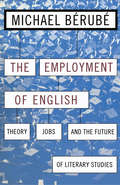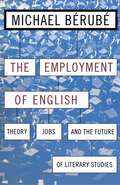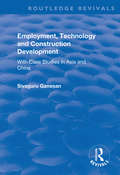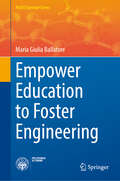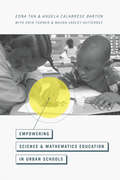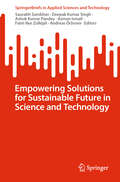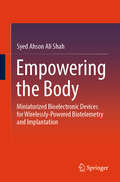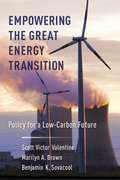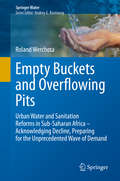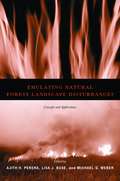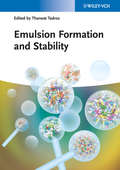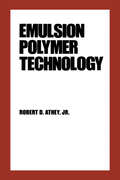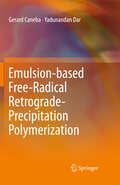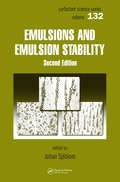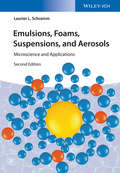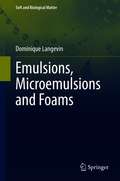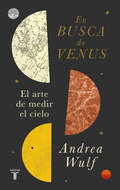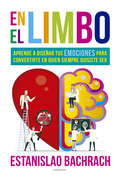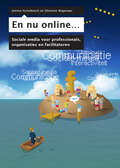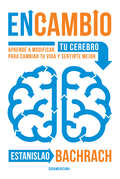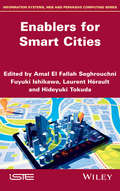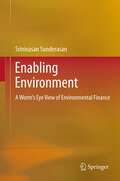- Table View
- List View
Employment of English: Theory, Jobs, and the Future of Literary Studies (Cultural Front #13)
by Michael BérubéWhat sorts of cultural criticism are teachers and scholars to produce, and how can that criticism be "employed" in the culture at large? In recent years, debates about the role and direction of English departments have mushroomed into a broader controversy over the public legitimacy of literary criticism. At first glance this might seem odd: few taxpayers and legislators care whether the nation's English professors are doing justice to the project of identifying the beautiful and the sublime. But in the context of the legitimation crisis in American higher education, the image of English departments has in fact played a major role in determining public attitudes toward colleges and college faculty. Similarly, the changing economic conditions of universities have prompted many English professors to rethink their relations to their "clients," asking how literary study can serve the American public. What sorts of cultural criticism are teachers and scholars to produce, and how can that criticism be "employed" in the culture at large? In The Employment of English, Michael Bérubé, one of our most eloquent and gifted critics, examines the cultural legitimacy of literary study. In witty, engaging prose, Bérubé asserts that we must situate these questions in a context in which nearly half of all college professors are part-time labor and in which English departments are torn between their traditional mission of defining movements of literary history and protocols of textual interpretation, and their newer tasks of interrogating wider systems of signification under rubrics like "gender," "hegemony," "rhetoric," "textuality" (including film and video), and "culture." Are these new roles a betrayal of the field's founding principles, in effect a short-sighted sell-out of the discipline? Do they represent little more that an attempt to shore up the status of--and student enrollments in--English? Or are they legitimate objects of literary study, in need of public support? Simultaneously investigating the economic and the intellectual ramifications of current debates, The Employment of English provides the clearest and most condensed account of this controversy to date.
Employment of English: Theory, Jobs, and the Future of Literary Studies (Cultural Front)
by Michael BérubéWhat sorts of cultural criticism are teachers and scholars to produce, and how can that criticism be "employed" in the culture at large? In recent years, debates about the role and direction of English departments have mushroomed into a broader controversy over the public legitimacy of literary criticism. At first glance this might seem odd: few taxpayers and legislators care whether the nation's English professors are doing justice to the project of identifying the beautiful and the sublime. But in the context of the legitimation crisis in American higher education, the image of English departments has in fact played a major role in determining public attitudes toward colleges and college faculty. Similarly, the changing economic conditions of universities have prompted many English professors to rethink their relations to their "clients," asking how literary study can serve the American public. What sorts of cultural criticism are teachers and scholars to produce, and how can that criticism be "employed" in the culture at large? In The Employment of English, Michael Bérubé, one of our most eloquent and gifted critics, examines the cultural legitimacy of literary study. In witty, engaging prose, Bérubé asserts that we must situate these questions in a context in which nearly half of all college professors are part-time labor and in which English departments are torn between their traditional mission of defining movements of literary history and protocols of textual interpretation, and their newer tasks of interrogating wider systems of signification under rubrics like "gender," "hegemony," "rhetoric," "textuality" (including film and video), and "culture." Are these new roles a betrayal of the field's founding principles, in effect a short-sighted sell-out of the discipline? Do they represent little more that an attempt to shore up the status of--and student enrollments in--English? Or are they legitimate objects of literary study, in need of public support? Simultaneously investigating the economic and the intellectual ramifications of current debates, The Employment of English provides the clearest and most condensed account of this controversy to date.
Employment, Technology and Construction Development: With Case Studies in Asia and China (Routledge Revivals)
by Sivaguru GanesanThis title was first published in 2000: An in depth analysis of employment and technology issues in the housing and construction industries of developing countries, in the context of globalization of economies and increased opportunities for advanced technology transfer. Supported by case studies from Asia including the misallocation of resources that led to the Asian crisis of 1997 and the experience of Shanghai in advanced technology transfer. Ganesan advances a number of strategies to achieve higher employment creation, a proper mix of resources and sustained growth.
Empower Education to Foster Engineering (PoliTO Springer Series)
by Maria Giulia BallatoreThis book highlights the pivotal role that engineering education researchers can play at technical universities. By delving into both theoretical and practical aspects, it showcases the transformative potential of integrating rigorous educational research into technical education. The book begins by outlining the current landscape of engineering education research and situates it within the unique context of the Italian educational system. This initial framework sets the stage for a detailed examination of the scope and limitations of the field. By understanding the experiences and challenges of both students and educators, the book bridges gaps and fosters an environment where educational practices are continuously improved and aligned with real-world demands. One of the key problems addressed is the disconnection often observed between educational theory and practical implementation. It provides actionable insights and recommendations that can help harmonize teaching methods with educational research findings. It offers strategies for enhancing student engagement, improving teaching methodologies, and ultimately producing graduates who are better equipped to meet the challenges of the engineering profession. This book serves as a valuable resource for educators, researchers, and policymakers dedicated to advancing the quality of engineering education, and by presenting a balanced analysis of students' and lecturers' perspectives, it offers a holistic view of the educational landscape and practical solutions for its improvement.
Empowering Science and Mathematics Education in Urban Schools
by Edna Tan Angela Calabrese Barton Erin E. Turner Maura Varley Gutiérrez.Math and science hold powerful places in contemporary society, setting the foundations for entry into some of the most robust and highest-paying industries. However, effective math and science education is not equally available to all students, with some of the poorest students--those who would benefit most--going egregiously underserved. This ongoing problem with education highlights one of the core causes of the widening class gap. While this educational inequality can be attributed to a number of economic and political causes, in Empowering Science and Mathematics Education in Urban Communities, Angela Calabrese Barton and Edna Tan demonstrate that it is augmented by a consistent failure to integrate student history, culture, and social needs into the core curriculum. They argue that teachers and schools should create hybrid third spaces--neither classroom nor home--in which underserved students can merge their personal worlds with those of math and science. A host of examples buttress this argument: schools where these spaces have been instituted now provide students not only an immediate motivation to engage the subjects most critical to their future livelihoods but also the broader math and science literacy necessary for robust societal engagement. A unique look at a frustratingly understudied subject, Empowering Science and Mathematics Education pushes beyond the idea of teaching for social justice and into larger questions of how and why students participate in math and science.
Empowering Solutions for Sustainable Future in Science and Technology (SpringerBriefs in Applied Sciences and Technology)
by Andreas Öchsner Azman Ismail Ashok Kumar Pandey Fatin Nur Zulkipli Deepak Kumar Singh Saurabh SambhavThis book, embarks the reader on a journey into the forefront of innovation where science, engineering, and technology converge to address the pressing challenges of our time. Through a captivating exploration of cutting-edge research, real-world case studies, and visionary insights, this book illuminates the dynamic forces shaping our collective journey towards a more sustainable and prosperous future. The book also explores how breakthroughs in science, engineering, and technology are reshaping our world for the better. This book is beneficial for research scholar, undergraduate and postgraduate students, or industry staff. The book inspires and empowers readers to become catalysts for positive transformation in our communities and beyond.
Empowering Young Voices for the Planet
by Lynne Cherry Ms Juliana Texley Suzanne E. LyonsBecause action is the best antidote to climate change! Use this manual to teach your students the science and reality of climate change, while empowering them to take action in their own communities. In this companion to the remarkable Young Voices for the Planet film series, you’ll find: Inspiring true stories of low- or no-cost youth-led projects that address a wide range of environmental issues Practical tips for inspiring students to develop projects relevant to their own communities, including planning, financing, safety, and liability Many creative and replicable ways to reduce CO2 emissions, as well as connections to the NGSS To view the films, visit www.youngvoicesonclimatechange.com.
Empowering the Body: Miniaturized Bioelectronic Devices for Wirelessly-Powered Biotelemetry and Implantation
by Syed Ahson ShahEmbark on a groundbreaking journey into the realm of miniaturized bioelectronic devices with "Empowering the Body." This captivating book delves into the world of wirelessly-powered biotelemetry and implantation, offering unparalleled insights into the future of healthcare monitoring. Discover the motivations driving the development of wireless implantable medical devices (WIMDs) and the challenges faced in their design. Unravel the mysteries behind biocompatibility, size miniaturization, patient safety, and impedance mismatches. Witness the innovative solutions that optimize performance and extend battery life, all while ensuring the utmost precision in therapy and treatment. Featuring state-of-the-art research, this book showcases cutting-edge advancements in miniaturized implantable antenna systems, ultra-small batteryless WIMDs, and deeply implanted stent antenna systems for endovascular aneurysm repair. Immerse yourself in a world of simulations, numerical analyses, and validation experiments, where the proposed systems are rigorously tested and proven to excel in heterogeneous human body tissue environments. "Empowering the Body" caters to a diverse audience of researchers, engineers, and medical professionals at the forefront of bioelectronic devices and wireless power transfer. Whether you're an expert in the field or a graduate student seeking knowledge, this book is your key to unlocking the potential of wireless healthcare solutions. Open the pages of this exceptional book and explore its unique approach, combining theoretical insights with practical applications. Gain a comprehensive understanding of how to overcome the limitations of current technologies, and be inspired by the possibilities that lie ahead. Don't miss your chance to be at the forefront of the biomedical revolution with "Empowering the Body."
Empowering the Great Energy Transition: Policy for a Low-Carbon Future
by Scott Valentine Benjamin Sovacool Marilyn BrownAt a time when climate-change deniers hold the reins of power in the United States and international greenhouse gas negotiations continue at a slow crawl, what options are available to cities, companies, and consumers around the world who seek a cleaner future? Scott Victor Valentine, Marilyn A. Brown, and Benjamin K. Sovacool explore developments and strategies that will help fast-track the transition to renewable energy. They provide an expert analysis of the achievable steps that citizens, organizational leaders, and policy makers can take to put their commitments to sustainability into practice.Empowering the Great Energy Transition examines trends that suggest a transition away from carbon-intensive energy sources is inevitable—there are too many forces for change at work to stop a shift to clean energy. Yet under the status quo, change will be too slow to avert the worst consequences of climate change. Humanity is on a path to incur avoidable social, environmental, and economic costs. Valentine, Brown, and Sovacool argue that new policies and business models are needed to surmount the hurdles separating the current consumption model from a sustainable energy future. Empowering the Great Energy Transition shows that with well-placed efforts, we can set humanity on a course that supports entrepreneurs and communities in mitigating the environmental harm caused by technologies whose time has come and gone.
Empty Breadbasket? The Coming Challenge to America's Food Supply and What We Can Do About It
by The Cornucopia Project of Rodale PressThe massive U.S. food supply which provides us with almost any food we want-at any time of year-is surprisingly fragile. Without a change in directions there will be a depletion of natural resources: soil, water, energy. This book is a result of the study conducted by the Cornucopia Project of Rodale Press to document the vulnerability, and suggest how consumers, farmers and food industry can improve.
Empty Buckets and Overflowing Pits: Urban Water and Sanitation Reforms in Sub-Saharan Africa – Acknowledging Decline, Preparing for the Unprecedented Wave of Demand (Springer Water)
by Roland WerchotaThis book provides a multi-level and multi-dimensional insight into urban water and sanitation development by analyzing sector reforms in Africa. With the recent events in mind - water shortages in Cape Town, widespread cholera in Haiti, mass-migration from low-income countries, etc. – it elaborates a pressing topic which is directly linked to the precarious living conditions of the urban poor in the developing countries. It is urgent to acknowledge the proposed findings and recommendations of the book which will help to improve the situation of potential refugees in their home countries with a realistic vision for the development of the most basic of all life supporting services.So many efforts to reverse the negative trend in water and sanitation development have failed or targets have been repeatedly missed by far without notable consequences for decision makers on different levels and institutions. It has unnecessarily consumed many young lives, contributed to keep billions in poverty until today and fostered discrimination of women. The knowledge gap and the confusion in the sector lined out in the book becomes evident when a national leader in a low-income country declares a state of emergency in urban water and sanitation while at the same time global monitoring publishes an access figure for urban water of over 90% for the same country. It is time to change this with an effective sector development concept for our partner countries and a more realistic discourse on global level.The book argues for a sweeping rethinking and combines extended local knowledge, lessons learned from history in advanced countries and thorough research on reforms in Francophone and Anglophone developing countries. This was possible because the writer was working in Sub-Saharan partner countries for almost 30 years as an integrated long term advisor in different sector institutions (ministry, regulator, financing basket and different sizes of utilities) and had the opportunity to cooperate closely with the main development partners.The reader has the opportunity to obtain a comprehensive understanding of how the sector works and sector institutions in low-income countries function and can discover the reasons behind success and failures of reforms. The book also covers issues which have a significant influence on urban water and sanitation development but are hardly the subject of discussions. It helps to make the shortcomings of the water and sanitation discourse more apparent and assist institutions to move beyond their present perceptions and agendas. All of this makes the book different from other literature about urban water and sanitation in the developing world.
Emulating Natural Forest Landscape Disturbances: Concepts and Applications (Forest Research Information Paper Ser. #No. 149)
by Lisa J. Buse Michael G. Weber Eds. Perera Ajith H.What is a natural forest disturbance? How well do we understand natural forest disturbances and how might we emulate them in forest management? What role does emulation play in forest management? Representing a range of geographic perspectives from across Canada and the United States, this book looks at the escalating public debate on the viability of natural disturbance emulation for sustaining forest landscapes from the perspective of policymakers, forestry professionals, academics, and conservationists. This book provides a scientific foundation for justifying the use of and a solid framework for examining the ambiguities inherent in emulating natural forest landscape disturbance. It acknowledges the divergent expectations that practitioners face and offers a balanced view of the promises and challenges associated with applying this emerging forest management paradigm.The first section examines foundational concepts, addressing questions of what emulation involves and what ecological reasoning substantiates it. These include a broad overview, a detailed review of emerging forest management paradigms and their global context, and an examination of the ecological premise for emulating natural disturbance. This section also explores the current understanding of natural disturbance regimes, including the two most prevalent in North America: fire and insects. The second section uses case studies from a wide geographical range to address the characterization of natural disturbances and the development of applied templates for their emulation through forest management. The emphasis on fire regimes in this section reflects the greater focus that has traditionally been placed on understanding and managing fire, compared with other forms of disturbance, and utilizes several viewpoints to address the lessons learned from historical disturbance patterns. Reflecting on current thinking in the field, immediate challenges, and potential directions, the final section moves deeper into the issues of practical applications by exploring the expectations for and feasibility of emulating natural disturbance through forest management.
Emulsion Formation and Stability
by Tharwat F. TadrosThe importance of emulsification techniques, their use in the production of nanoparticles for biomedical applications as well as application of rheological techniques for studying the interaction between the emulsion droplets is gathered in this reference work.Written by some of the top scientists within their respective fields, this book covers such topics as emulsions, nano-emulsions, nano-dispersions and novel techniques for their investigation. It also considers the fundamental approach in areas such as controlled release, drug delivery and various applications of nanotechnology.
Emulsion Polymer Technology (Plastics Engineering)
by Bo Hu Robert D. Athey Anthony WangAn explanation for engineers and chemists working in such industries as paper, paint, and textiles, of the operating mechanisms involved in the physics and chemistry of polymers and colloids as they apply to emulsion polymer manufacture and use. Outlines the various available materials, how they are
Emulsion-based Free-Radical Retrograde-Precipitation Polymerization
by Gerard Caneba Yadunandan DarThis monograph is a follow-up material to the first FRRPP book by Gerard Caneba in 2009. It includes additional conceptual results, implementation of the FRRPP process in emulsion media to produce various block copolymers, and other FRRPP-related supplementary topics. Conceptual topics include the application of the quantitative analysis presented in the first FRRPP monograph for the occurrence of the FRRPP process to the polysterene-styrene-ether (PS-S-Ether) and poly(methacrylic acid)-methacrylic acid-water (PMAA-MAA-Water) systems, as well as extensions through unsteady state analysis of the occurrence of flat temperature profiles. Also, the generalization of the quantitative analysis is done to consider molecular weight effects, especially based on changes of the phase envelope to an hourglass type. Topics in implementation of the FRRPP process from pre-emulsions of monomers and the solvent/precipitant are highlighted. Additional FRRPP topics are included in this monograph that pertain to more recent efforts of Gerard Caneba, such as oil spill control, oil dispersant system, and caustic sludge remediation from emulsion-based FRRPP materials, hydrolysis of vinyl acetate-acrylic acid-based copolymers, and other polymer modification studies from FRRPP-based emulsions.
Emulsions and Emulsion Stability: Surfactant Science Series/61 (Surfactant Science)
by Johann SjöblomEmulsions and Emulsion Stability, Second Edition provides comprehensive coverage of both theoretical and practical aspects of emulsions. The book presents fundamental concepts and processes in emulsified systems, such as flocculation, coalescence, stability, precipitation, deposition, and the evolution of droplet size distribution.The bo
Emulsions, Foams, Suspensions, and Aerosols
by Laurier L. SchrammThis is the first book to provide an integrated introduction to the nature, formation and occurrence, stability, propagation, and uses of the most common types of colloidal dispersion in the process-related industries. The primary focus is on the applications of the principles, paying attention to practical processes and problems. This is done both as part of the treatment of the fundamentals, where appropriate, and also in the separate sections devoted to specifi c kinds of industries. Throughout, the treatment is integrated, with the principles of colloid and interface science common to each dispersion type presented for each major physical property class, followed by separate treatments of features unique to emulsions, foams, or suspensions. The first half of the book introduces the fundamental principles, introducing readers to suspension formation and stability, characterization, and fl ow properties, emphasizing practical aspects throughout. The following chapters discuss a wide range of industrial applications and examples, serving to emphasize the diff erent methodologies that have been successfully applied. The author assumes no prior knowledge of colloid chemistry and, with its glossary of key terms, complete cross-referencing and indexing, this is a must-have for graduate and professional scientists and engineers who may encounter or use emulsions, foams, or suspensions, or combinations thereof, whether in process design, industrial production, or in related R&D fields.
Emulsions, Microemulsions and Foams (Soft and Biological Matter)
by Dominique LangevinThis book takes an interface science approach to describe and understand the behavior of the dispersions we call emulsions, microemulsions and foams. The one thing all these dispersions have in common is the presence of surface-active species (surfactants) adsorbed at the interfaces between the two fluid phases that make up the emulsions, microemulsions or foams. The interfacial layers formed by the surfactants control most of the properties of the dispersions. The book describes the properties of interfacial layers, thin films and bulk fluids used in the elaboration of the various dispersions and it explains how such properties relate to the dispersion properties of these soft matter systems: structure, rheology and stability. These dispersion properties are far from being fully understood, in particular foam and emulsion stability. In discussing the state of the art of the current knowledge, the author draws interesting parallels between emulsions, microemulsions and foams that enlighten the interpretation of previous observations and point to a deeper understanding of the behavior of these materials in the future.
Emulsion‐based Encapsulation of Antioxidants: Design and Performance (Food Bioactive Ingredients)
by M. Ali AboudzadehThe limited aqueous solubility of bioactive pharmaceutical ingredients presents a tremendous challenge in the development of new drugs. In recent years, methods have been developed to protect these sensitive bioactive compounds, namely antioxidants, with the aim of increasing the public sanitation grades. Emulsion-based systems are particularly interesting as colloidal delivery encapsulation systems, because they can easily be created from food-grade ingredients using relatively simple processing protocols. It is one of the most favorable delivery systems to increase the solubility of phytochemicals, nutraceuticals and food additives.Emulsion‐based Encapsulation of Antioxidants: Design and Performance advances the field of colloid science through the investigation of the effects of formulation and process parameters that influence emulsion production. The book offers a deeper comprehension of the technological and biological aspects of the incorporation of encapsulated compounds in food matrices and explication of their activity. Chapters provide an overview of the status of emulsion-based formulations to encapsulate antioxidants, fabrication, properties, applications, and biological fate with emphasis on systems suitable for utilization within industry. Special emphasis is placed on the antioxidant activity of the carriers being the key advantage of these emulsion-based systems. The main aim of the book is to inspire and to guide fellow scientists and students in this field. Filled with illustrations, figures, case studies, practical examples, and historical perspectives, the book can also be used as a practical handbook or graduate textbook. For industry professionals, the book presents easy-to-achieve approaches to industrial pharmaceutical production.
En busca de Venus
by Andrea WulfEl emocionante relato de cómo los científicos ilustrados se unieron para medir las profundidades del universo. Durante dos días en 1761 y 1769, cientos de científicos de países europeos y de las colonias norteamericanas apuntaron sus telescopios hacia el cielo para observar un raro acontecimiento astronómico: el tránsito de Venus por delante de la superficie del Sol. Fueron enviados a los rincones más remotos de nuestro planeta para observar el encuentro celeste, que permitiría calcular el tamaño del sistema solar. En busca de Venus narra de manera extraordinaria la vida de las personas que se embarcaron en esta compleja y esencial aventura y nos ofrece un vívido retrato de las contribuciones y el entusiasmo que hubo detrás de la primera colaboración científica internacional, pero también nos presenta las rivalidades y los acontecimientos políticos que fueron obstaculizando cada paso de la investigación. Un libro rebosante de acción y detalles maravillosos que nos revela el espíritu de la Ilustración y la eterna obsesión del ser humano por entender el mundo. La crítica ha dicho...«Una aventura cautivadora. El maravilloso ojo de Wulf para los detalles y su talento a la hora de volver accesibles las complejidades científicas hacen de este libro una lectura muy recomendable.»San Francisco Chronicle «Un libro que tanto los astrofísicos como los poetas pueden comprender.»The Boston Globe «Apasionante. Sin duda será uno de los libros de no ficción del año. No se pierdan esta maravillosa obra.»The Daily Mail «Una historia seductora. La sensibilidad de Wulf para entender las personalidades y su atención tanto a los registros científicos como a los diarios de los astrónomos dan vida a sus hazañas como exploradores, pero también como aventureros.»The Washington Times «Un estupendo ejemplo de narración científica. Relatado con elegante pericia.»The Times «Una historia muy humana y una entusiasta invitación a la exploración del universo por placer.»The Daily Telegraph «Magistral. Wulf relata la impresionante transformación de Venus de objeto de asombro mitológico a instrumento para la revelación científica.»The Guardian «Emocionante. Wulf cuenta una historia cautivadora y fascinante.»The Independent
En el limbo: Aprendé a diseñar tus emociones para convertirte en quien siempre quisiste ser
by Estanislao BachrachCon Ágilmente Estanislao Bachrach puso de moda la neurociencia. Con En el limbo -luego de años de investigación- el divulgador científico más lúcido de la década nos presenta una nueva teoría sobre las emociones que barre por completo con los viejos conceptos que aún hoy intentan imponer los ensayos de autores que repiten viejas fórmulas. Este libro te va a acompañar al limbus, al límite, al borde de tu zona de confort. Porque vos podés convertirte en la persona que siempre quisiste ser. Sin duda son las emociones las que hacen que vivir valga la pena. Todos atravesamos diversos estados emocionales a lo largo de la vida y muchas veces sentimos que nos dominan. No solo no los podés evitar sino que son fundamentales a la hora de tomar decisiones. Tanto si querés ser un líder o una mejor persona, es clave que conozcas, entiendas y regules tus emociones. Sin embargo, te han enseñado muy poco sobre ellas. Pero aquí la gran noticia: si bien experimentás emociones sin esfuerzo consciente, eso no significa que seas un receptor pasivo de estas experiencias. A pesar de tu historia las podés rediseñar empleando tus pensamientos, modificando el contexto y conociendo cada vez mejor tu cuerpo. Tus emociones te aportan información sobre tu bienestar. Son datos, no direcciones. En el limbo es una herramienta esencial de autoconocimiento científico para que aprendas a utilizar tus emociones en beneficio propio. Este libro te enseñará que cualquier habilidad puede ser desarrollada. Es importante que dejes de negar u omitir una emoción y que te preguntes qué es lo que está tratando de decirte. Vos sos el dueño de tus emociones, podés diseñarlas y así diseñar tu propia vida.
En nu online...
by Sibrenne Wagenaar Joitske HulseboschOnline leren en faciliteren met sociale media, zoals twitteren, bloggen en wiki-en.
EnCambio: Aprendé a modificar tu cerebro para cambiar tu vida y sentirte mejor
by Estanislao Bachrach"Este año cambio de trabajo, empiezo el gimnasio, bajo esos kilitos de más, aprendo un idioma nuevo"Cambiar. Esa es la cuestión.A veces te da tanto miedo no lograrlo que ni siquiera lo intentás. Te decís que sos así, que ya no podés cambiar.Vivís en piloto automático, reaccionando a las diversas situaciones del día a día casi sin pensar. Algunos de estos comportamientos te hacen eficiente, pero otros son detractores de eso que querés hoy para vos.Esto no es casual. No sos vos, es tu cerebro. Estas reaccionesautomáticas son determinadas por patrones cerebrales que vasconstruyendo a lo largo de tu vida.EnCambio te va a permitir alumbrar los procesos por los cuales pensás, sentís y te comportás de determinada manera, y así dejar atrás aquellos hábitos y conductas que ya no te sirven. El objetivo es que aprendas el potencial que tiene tu cerebro para cambiar y la capacidad que tenés vos para modificarlo.En este libro encontrarás la forma de conocerte mejor, paso fundamental para lograr un mayor bienestar, y las herramientas para que puedas cambiar pensamientos, emociones y acciones que entorpecen la vida que querés, con el fin de conseguir objetivos a largo plazo, personales y profesionales.Con ÁgilMente, Estanislao Bachrach llevó el conocimiento científico del cerebro a la vida cotidiana de miles de lectores. EnCambio lo instala definitivamente como el gran divulgador de la biología de nuestro órgano más complejo y preciado.
Enablers for Smart Cities
by Fuyuki Ishikawa Hideyuki Tokuda Amal El Seghrouchni Laurent HéraultSmart cities are a new vision for urban development. They integrate information and communication technology infrastructures - in the domains of artificial intelligence, distributed and cloud computing, and sensor networks - into a city, to facilitate quality of life for its citizens and sustainable growth. This book explores various concepts for the development of these new technologies (including agent-oriented programming, broadband infrastructures, wireless sensor networks, Internet-based networked applications, open data and open platforms), and how they can provide smart services and enablers in a range of public domains. The most significant research, both established and emerging, is brought together to enable academics and practitioners to investigate the possibilities of smart cities, and to generate the knowledge and solutions required to develop and maintain them.
Enabling Environment
by Srinivasan SunderasanEnabling Environment is as real as it gets. The global commons are jointly owned and their inhabitants are jointly obligated to ensure their preservation. In the face of protracted negotiations, convoluted documentation, discord, and incessant bickering among scientists, activists, pressure groups of various hues, politicians and negotiators, very often the people on the ground are ignored or taken for granted. In the meantime, life meanders along. It is these 'everyday individuals' who make consumption-related choices on their lifestyles, travel or on preferring certain products or services over others. Enabling Environment puts the individual front and center. Ecosystem services need to be recognized, appropriately priced and the costs allocated to the agents concerned. Enabling Environment is about defining economic and non-economic incentive structures and utilizing them to arrive at pro-environmental outcomes. This collection of articles illustrates the use of existing social, economic and regulatory structures, and the financial architecture and instruments, suitably modified or extended, to help internalize the environmental externality.
